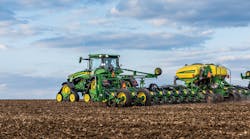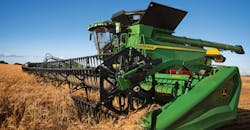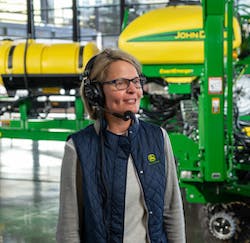The many advances fueling modern farming are nothing short of phenomenal. Today’s agricultural equipment essentially translates to smart factories on wheels including autonomous operation, sensor backed data collection as well as the innate ability to recognize and address potential issues on the fly.
However, even with so many smart pieces of equipment, the real value comes from the amazing level of interconnectivity driving enhanced decision-making capabilities despite the many fluctuating factors farmers face such as weather, diseases or pests.
The source of the interconnectivity powering these rolling factories? IIoT.
Understanding the IIoT fueled farm
Through constant internal development efforts and the investment in technology pioneers over the years, John Deere has developed as closed looped of a system as possible, interweaving an array of smart agriculture components to fully enable today’s farmer.
It is because of IIoT that predictive maintenance is already a standard service for Deere. As such, farmers today leverage machines that indicate proactively when they might need service before ever compromising uptime. Specifically, Expert Alerts utilize JDLink machine connectivity and data analytics to predict service needs, reduce diagnostic time and minimize downtime.
“At Deere, we are not just creating standalone products – we’re building an entire way of operating that benefits not only farmers, but the entire world,” says John Deere’s Jenny Ose. “IoT at the fleet level will allow for even more communication between machines operating in a field so more precise decisions can be made.”
The IIoT connection enables machines to communicate with one another and the John Deere Operations Center, a cloud-based platform featuring over 180 connected software companies. Climb into one of these machines and the dashboard immediately makes the operator aware of exactly what’s going on across the entire farm. For instance, understanding which equipment is operating in each individual field, what operation each piece of equipment is completing as well as real-time updates on when each machine needs service (including the ability to immediately initiative service).
“Understandably, connectivity plays a pivotal role in enabling precision, which is why JDlink now comes standard on production agricultural equipment,” says Ose.
Escaping pilot purgatory
Unfortunately, IIoT is not always a smooth process for all organizations. Instead, many manufacturers tend to find themselves stuck in what is commonly coined pilot purgatory. A pilot project is announced and launched with great fanfare, but what worked as a pilot cannot be scaled, often for reasons that are never fully understood.
And, reaching the level where IIoT is at the heart of how an organization operates requires scale well beyond the pilot.
There are two very distinct approaches and views of IIoT today, which often determines how organizations fare when scaling IIoT projects, explains Manoj Mehta, Cognizant’s global head of Industry 4.0, IoT and engineering. Cognizant recently partnered with Forrester to assess how companies can quickly move IoT pilots to scaled initiatives.
“First are the companies with a very clear vision around IoT, usually centered around embracing new revenue models, such as a large pump manufacturer who sees IoT as an opportunity to embrace predictive maintenance,” says Mehta. “The second group are the organizations who are still trying to dabble with what’s next? How do I use it properly? This is where we have seen pilots that are not scaling up. This is where it is crucial to figure out the use cases that matches your industry – and look like what they aim to accomplish.”
The Cognizant research yielded five key levers companies have been successfully applying to move IoT initiatives past the pilot phase quickly. These include:
- Organizational enablement. The proper skills, training, and tools to drive adoption of use cases forward. “The enablement of the organization is crucial,” says Mehta. “Who's buying into this? What's the support -- much like any change management initiative within an organization.”
- Infrastructure/technology. The technical capability to support and manage IoT deployments and corresponding data.
- Integration. Designing projects to eliminate silos to unlock critical data that was previously inaccessible. “There's a clear structure on where we're going with Industry 4.0, but it's the functional silos between IT/OT internally,” he says. “That's where we see lack of efficiency, lack of knowledge.”
- Strategy. The degree to which a company has executive alignment and support for its IoT initiatives. “There needs to be a clear tie to a business outcome. What is the strategy? Where is this going? For this to happen, financial strategy needs to be very clear,” he says.
- Data/analytics. A company’s ability to use data from assets, systems or IoT-enabled products to drive improvements in decision-making and generate new sources of revenue. “This is less of an issue for sectors like connected cars where the data-driven capabilities are core to the entire offering,” he says. “However, for others the ability to leverage and scale data expertise can quickly become an obstacle.”
“When all of these come together, it is necessary to scale them carefully, and it really needs to be driven top down,” he says. “Engaging with an ecosystem of partners to right mix of skills and capabilities can provide manufacturers with an end-to-end perspective. Companies need a single pane of glass to get a view around operations and efficiency. Partners play an important role in stitching the whole ecosystem together.”












